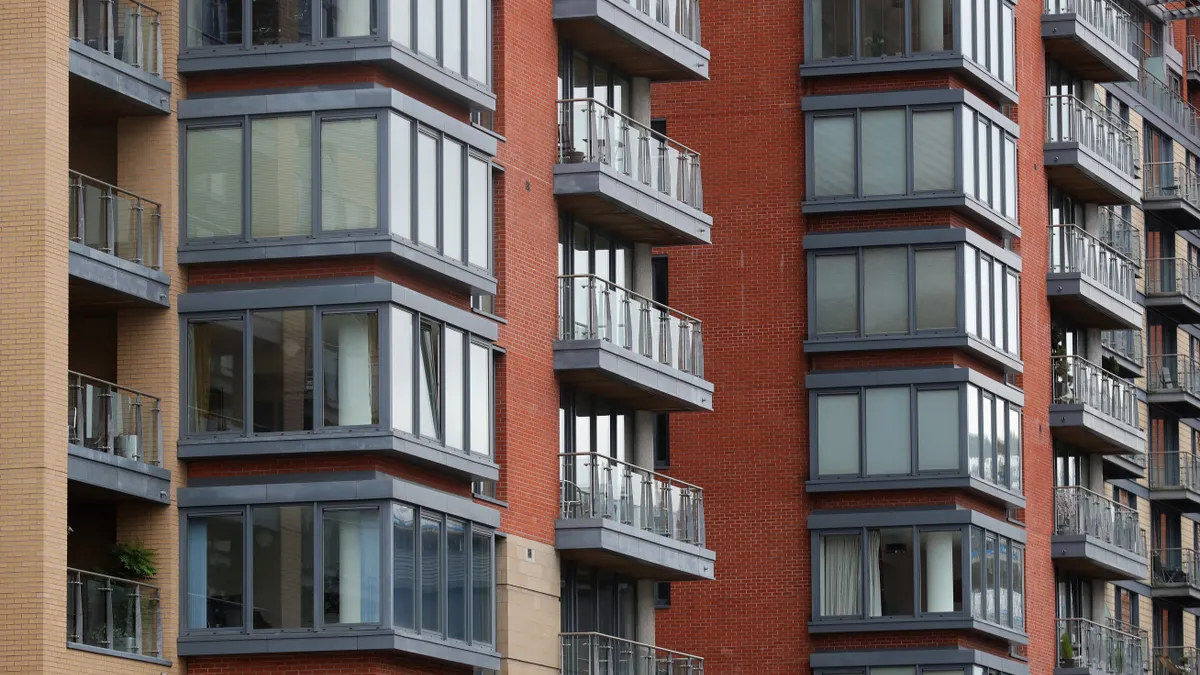2021 is a pivotal year for Irving, Texas-based multifamily developer and builder JPI.
At the beginning of the pandemic last spring, multifamily observers questioned whether apartments would ever recover, as more people opted for the lower density of single-family homes. But as COVID-19 subsides, JPI is seeing a surge in demand for its apartments and a groundswell of interest from investors looking to pour money into the sector.
Here, Construction Dive talks with Katie Willis, JPI's senior vice president and construction partner who leads all of the firm's construction and preconstruction efforts in the Central region, to find out what the company is building today, how it's dealing with material cost increases and the qualities it looks for in its subcontractors and construction partners.
CONSTRUCTION DIVE: Tell me about JPI. What role do you play in multifamily construction?
KATIE WILLIS: We are a developer and merchant builder of multifamily projects. So we will acquire land, we will capitalize it, we will design it using a third-party architect and then ultimately we have an in-house GC group — which is where I work in our Central Region — and then we build and lease up those properties. We are soup to nuts throughout the multifamily stack.
How much of the work on your projects do you self perform?
As the GC, we typically don't self-perform anything. We use subcontractors.
Although given the cost challenges with lumber right now, we have semi-self performed framing at times, where we will purchase the framing direct, and even the labor direct. But that's more a result of the current lumber market than is a long-term strategy for us.
What is your outlook for multifamily construction in 2021?
Our business is growing. We are tripling our project starts and projects under construction, from the 1,535 units we started last year. So we are actively looking for additional subcontractors and trade partners on those projects.
The biggest reason for that increase in starts is the increase of investors and capital. We're in a unique spot that we've not been in, probably for the 30-year life of the company, where we have more investors than we have projects for them to invest in. So we're actively trying to figure out how we can start more projects.
What type of locations and product are you focused on currently?
Most of our planned starts in our pipeline for this year and next year are in a more suburban settings. In the past, JPI focused a lot on the urban core, we did a lot of podium-wrapped product types. We're finishing up construction on those now, and going forward we're really shifting more towards a walkup, garden-style product.
When you seek out construction partners to help you build your projects, what are you typically looking for?
Some of the things that we're looking for right now is obviously quality of work. That's what JPI's reputation is based off of, is the quality of the projects that we deliver. So we expect high quality from our subcontractors, and we look for subcontractors that are willing to problem-solve and work with us, because nothing is ever without challenges. So it's all about how we work together to figure it out, rather than becoming adversarial.
But we're also looking for partners who help us drive schedule because schedule is sometimes more important than cost for us.
Why is schedule sometimes more important than cost on your projects?
Like other developers, our final product is revenue producing. So we are looking to get heads in beds and leases signed to produce revenue for our project. The cost of the construction is only a small piece of the overall project cost, and the revenues help offset that.
It's no trade secret that an interest carry and loss of revenue can add up to over $10,000 a day on a project of that size. A lot of our properties are around 350 to 400 units. We'll open up the clubhouse, and anywhere from 40 to 100 units, while we're still building out the rest of the property.
So we're always looking to figure out ways to have an accelerated schedule in order to deliver those first units and that clubhouse. And so if we find a trade partner who helps us deliver on it, we're more than happy to pay a premium to utilize them.
How are increased material prices impacting your projects?
On projects in our pipeline, we're seeing dramatic increases, over 8% escalation. We're definitely feeling the impact on construction costs going forward. It's also changing our approach on how we even contract the project. I mentioned earlier on lumber, how we're looking more and more at buying lumber direct from a risk mitigation standpoint, not even for cost savings, so that we're direct with the broker versus using a subcontractor to obtain the materials and labor.
We're also looking at purchasing and locking in our subcontractor agreements even faster, before we even have a notice to proceed and before we actually close on the loan on our project
Who ends up paying for those increased costs?
JPI does, but it also impacts the rents that are dictated by the market. Rents are continuing to increase, so the end user is paying for it, too. But then investors are as as well, because investors have been willing to take lower returns at this point in time.
But JPI ends up having to absorb that, and then through the course of our development, our apartment renters and investors do, as well.























